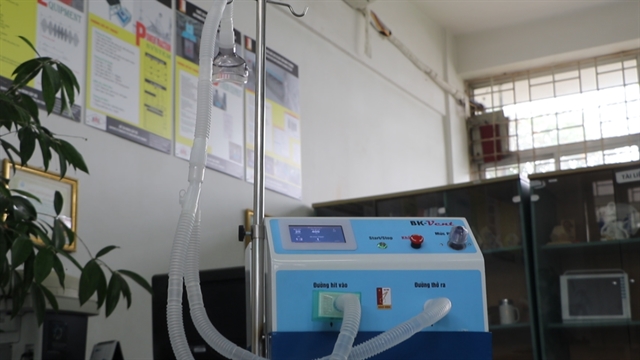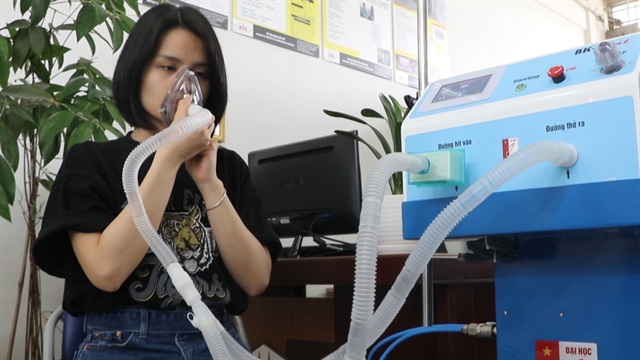 Society
Society

Academics and students at a Hà Nội university have designed and built a ventilator to help the country fight COVID-19.
Ly Ly Cao and Minh Phương
Academics and students at a Hà Nội university have designed and built a ventilator to help the country fight COVID-19, and if necessary they say they can produce up to 500 machines a month for hospitals and health centres nationwide.
The group from the Hanoi University of Science and Technology spent a month during the social distancing period to research and design the breathing support machine, called BK-Vent.
Associate Professor Vũ Duy Hải, one of the group's leaders, said: “Over the past month, we have completed our research and created a ventilator which has breathing support functions for COVID-19 patients that meet standards set by the Health Ministry and the Association for Advancing Safety in Health Technology.
“Now the ventilator from the Hanoi University of Science and Technology has been completed and certified by the National Institute of Medical Devices and Construction under the Health Ministry.”

|
| The ventilator is designed to help the country fight against COVID-19. VNS Photo — Minh Phương |
Understanding the symptoms of COVID-19 patients, the groups concentrated on the most basic functions of the machine.
“To create a ventilator for COVID-19 patients, the team investigated which functions on a normal ventilator COVID-19 patients need,” said Doctor Đào Việt Hùng, a member of the group.
“We concentrated on those functions and ignored those that are not needed by COVID-19 patients.
“The most basic principle of this ventilator is that the machine supplies air containing oxygen to patients’ lungs, because COVID-19 patients have trouble breathing.”
According to the National Steering Committee for COVID-19 Prevention and Control, Việt Nam has only 5,000 imported ventilators with just 260 units in Hà Nội, and they all use the invasive positive pressure ventilation method.
The machine invented by the group is for non-invasive positive pressure ventilation in order to meet the requirements set by the Government and when the number of COVID-19 patients exceeds 50,000.
“The BK-Vent machine has two modes," Hùng added.
“The first mode is auto-breathing recognition, which means if a patient is only breathing lightly, the machine recognises this and pumps air into the lungs.
“This mode helps the patient feel more comfortable.”

|
| A student tests the ventilator. VNS Photo — Ly Ly Cao |
One of the challenges of creating the machine was to ensure all the parts could be sourced in Việt Nam so nothing needed to be imported.
He added: “The difficult things that we had to cope with while making the BK-Vent ventilator was to ensure the ventilator can support COVID-19 patients and that we used domestic materials.
“If the COVID-19 situation gets worse in Việt Nam, our university can produce a large number of ventilators using local materials in the shortest time.”
Due to the limited number of ventilators, the group aims to make sure their machines can be mass-produced when needed and are cheaper than imported equipment.
“We're ready for mass production for health establishments if the disease gets worse,” Hải said.
“When the demand for ventilators is high like it was for face masks or disinfectant, the school will be able to produce 300–500 units per month.
“With our current estimation of raw material costs, the ventilator is much cheaper than imported machines.”
Even though the group had to work during social distancing, they still co-operated well and completed the task in a short space of time.
Hoàng Thị Thu Hiền, a student at the Hanoi University of Science and Technology and also a member of the group, said: “We worked during a tough time when social distancing was in place. We had to organise online meetings, and our staff numbers at that time were limited.
“We always had to work lat into the night.”
While the group's members are pleased they managed to create and design the machine quickly, they feel most proud of the contributions they have made to fighting the pandemic, which has claimed more than 300,000 lives worldwide.
“I feel very happy that I became the part of this project and contributed something to prevent the COVID-19 pandemic and support COVID-19 patients,” Hiền added.
“I think this was also a wonderful opportunity for me to apply theory in practice.”
“Being directly involved in the manufacturing process, we feel very happy,” Hùng said.
“We also feel very relieved because we have completed the task assigned by the university, and we are proud of what we have done.”
The COVID-19 pandemic will not be the end for their creative minds, and they believe that in the future they can create a better machine for other diseases to replace imported ventilators.
“If there is another opportunity for us to conduct research and manufacture ventilators for other diseases, we will likely participate in that project to supply to domestic and overseas markets,” Hùng continued.
“I think we can do it and do it well if we have that chance.” — VNS




